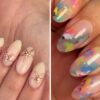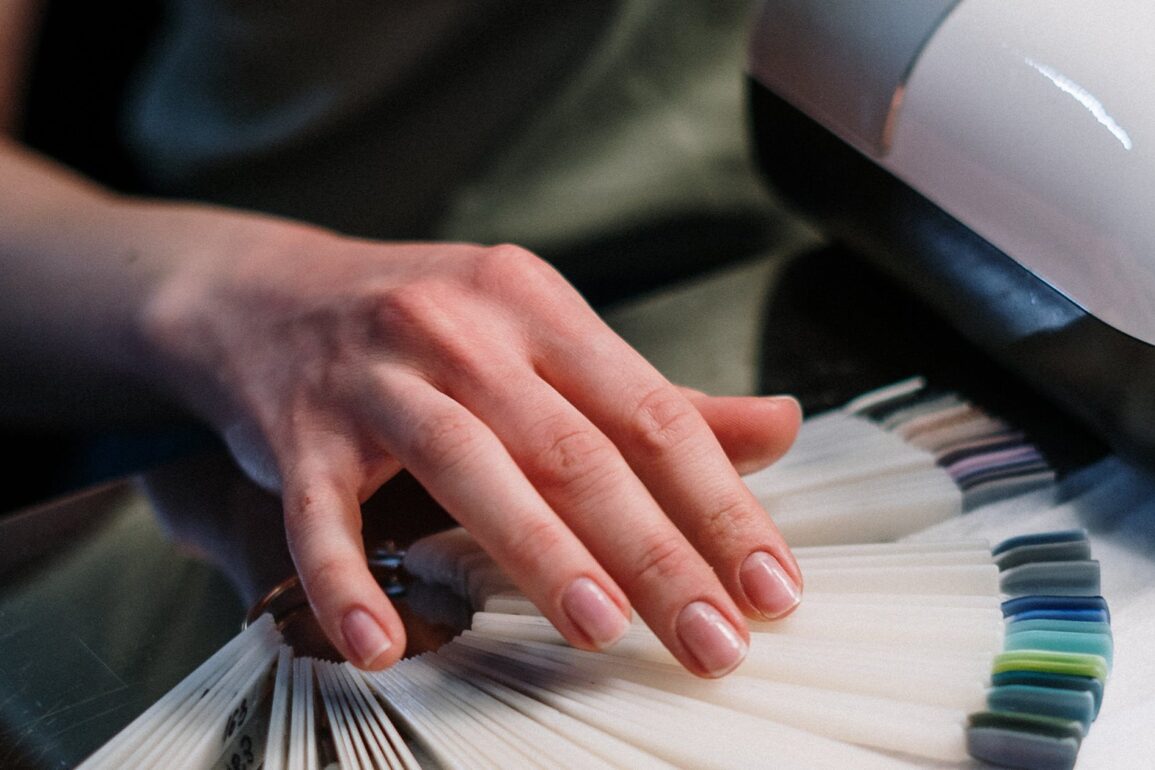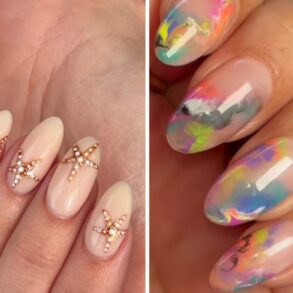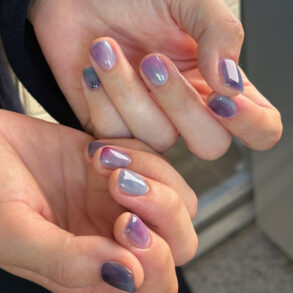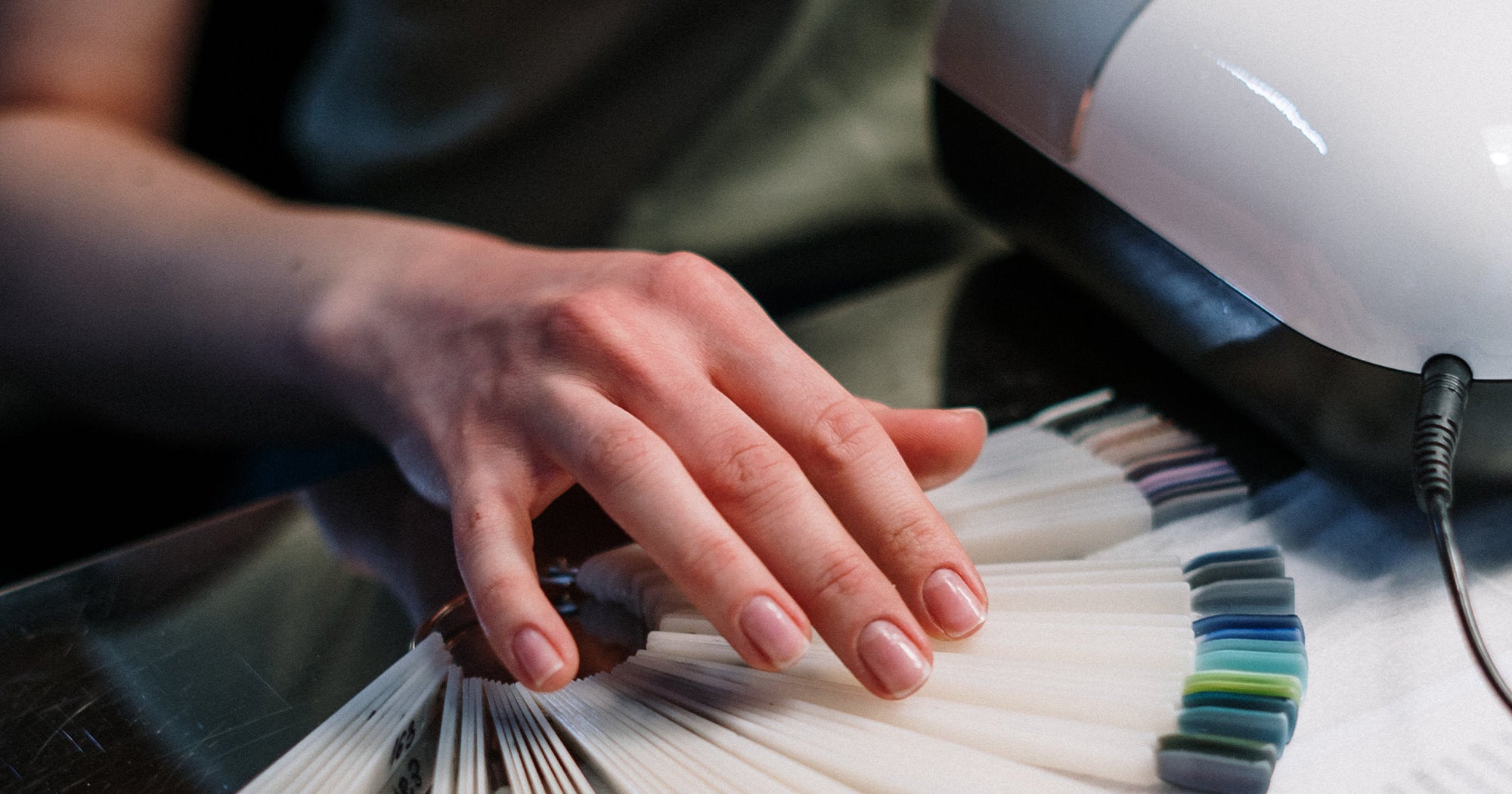
The nail salon is usually my happy place, but this time, something is seriously wrong. As the purple glow of the UV nail lamp washes over my freshly-lacquered nails, an intense burning sensation spreads insidiously across each nail bed. I tell myself it’ll pass, but it’s like flames are engulfing my fingers. I gasp, pull my hand back and look to my nail technician for reassurance. She’s dismissive. Unsteady on the chair, and now a little delirious, I force deep breaths through my nose for the remainder of the manicure. I remember the old adage: “Beauty is pain”.
Or is it?
I’ve been a builder in a bottle [BIAB] gel nail devotee ever since it took the UK by storm last year. In the past, manicurists have accidentally nicked my fingers with cuticle scissors and carelessly filed away my skin, but I’ve never felt discomfort like this before. So much so, I’m sworn off BIAB and gel manicures altogether, and I’m not the only one. A quick whip round friends and colleagues proves that many others have experienced this exact uncomfortable phenomenon — known as ‘heat spikes’ — during gel manicures. Sometimes, the pain can be unbearable.
“It felt like my fingers were going to explode,” one friend told me. “The nail artist said that this usually happens with a thick builder in a bottle polish, but she hinted that I was overreacting. I was really embarrassed.” Regular gel polish isn’t immune to the dreaded singe, either. A colleague said that she has to take regular breaks from the UV lamp during her fortnightly gel manicure while one friend recalls being reduced to tears; she couldn’t stand the burn and had to leave halfway through, uncured nails and all.
So should your manicure — something meant to be an enjoyable experience — hurt this much? And when should you start to worry?
Why does my gel manicure burn?
Heat spikes are nothing new. Metta Francis, award-winning nail artist and technician, explains that it’s a name given to the exothermic reactions (which prompt the release of heat) that are typically experienced during gel nail treatments and acrylic manicures. “They occur when tiny molecules bond together and harden or ‘cure’. With gel polish, hard gel and builder gel, bonding happens when your nails are under the UV/LED lamp,” says Francis. A slight warm sensation is normal when curing gel polish under UV light, but intense heat spikes are characterised by a burning sensation that can be distressing.
A number of things can exacerbate heat spikes: Primarily, the way that your manicurist might apply gel or acrylic polish. In particular, builder gel. It’s not uncommon for some technicians to apply one, thick layer of builder gel (rather than layering it finely, as it is meant to be used) in a bid to save time. The same goes for acrylics. This may increase the likelihood of heat spikes, says Francis, because the amount of gel increases the number of molecules reacting together.
@nhnailsxx It’s perfectly normal and is called a “heat spike” just take your hand out the lamp and it’ll stop the wee nippy feeling 🥰 always use low heat mode on your lamps girls this will help avoid this happening ❤️ #heatspikes #nailappointment #nailtechmeme #nailfunny #nailvideos2022 #nailmemesoftheday #notd ♬ Shut Up – Participation Certificate
Session manicurist Ami Streets says that a thicker layer of gel may need a longer curing time, which can worsen the hot sensation. Streets adds that reactions to specific ingredients in certain polishes, such as HEMA (hydroxyethyl methacrylate, a common (meth)acrylate that can cause allergic sensitisation), can also intensify heat spikes and severe discomfort, resulting in swelling, redness, itching or rashes around the nails or on surrounding skin.
Typically, heat spikes are experienced when natural nails are already sensitive. This could be genetic, or thanks to certain medications you might be taking. It could even be linked to your menstrual cycle and how sensitive to pain you might be at certain times, suggests Francis. However, the most common reason for feeling heat spikes is often damage to your nail plate. “Over-filing or buffing the nail plate and aggressive removal of gel polish and acrylics can all [thin the nail],” adds Francis. “Healthy” nails may also experience heat spikes, she adds, but this is less likely, as the nails are not compromised.
Heat spikes are regarded as part and parcel of a gel manicure, but ignoring them when they start to hurt could have a detrimental impact on your nail health. “Heat spikes that are experienced frequently and for a prolonged period (every nail appointment) could lead to separation of the nail plate, also known as onycholysis [pronounced onny-collo-siss],” explains Francis. “This is when the natural, white part of your nail (the tip) appears to start receding towards the cuticle area.” Eventually, this could result in separation, where your nail comes free from the edge of your fingertip, potentially leaving you vulnerable to infection.
@itslakishaa Reply to @zoeelovett837 are short nails a mood? 💫 #shortnails #healthynails #nailgrowthjourney #damagednails #nailtok #onycholysis @sallyhansen #nailhealth #nailgrowthtips ♬ vlog type beat – Fleeky
Happily, there are a number of steps you can take to avoid heat spikes. The obvious one is to give your nails a lengthy break from gel and acrylic manicures altogether, particularly if they have become thin and weak over time as a result of filing and buffing. Streets suggests taking supplements and applying a daily slick of cuticle oil to moisturise nails and the surrounding skin. If you do head back to the salon, Francis advises asking your manicurist whether their chosen UV/LED lamp corresponds to the brand of gel nail polish or builder gel they’re using to minimise potential complications. A professional nail lamp often boasts fixtures which reduce heat spikes, such as slow curing settings and pulsing lights, says Francis. Nail artist and content creator, Sadie Jordan, rates The Gel Bottle Light the Way lamp, £142.80. “It’s also important to use high quality and reputable products and to apply thinner layers,” says Francis, especially when it comes to builder gel.
Whatever you do, don’t wait intense heat spikes out, says Jordan. “If the pain is truly unbearable, remove your hand from the lamp immediately and flip your hand upside down to avoid ‘flooding’ your cuticles — essentially messing up your nails with uncured gel polish.” Try to resist the urge to shake your hands all over the place, too, she advises.
Are cuticle cutters and drills safe to use during a manicure?
There has been an influx of manicure trends that enlist drills (or e-files) to clean the nail bed and tidy up cuticles, such as the popular Russian and Ukrainian manicures. The thought (and sound) might be wince-inducing, but contrary to popular belief, e-files aren’t inherently bad. All four nail experts I spoke to for this article agree that when used correctly, they can be beneficial, particularly when it comes to removing synthetic enhancements like acrylic or builder gel. But it is possible to go too far.
Streets agrees that e-files are highly powerful and that they can cause serious damage in the wrong hands. “Excessive or improper use on natural nails can damage, weaken and thin the nail plate over time,” she says. Similar to heat spikes, if you feel a hot, uncomfortable sensation when your manicurist is holding an e-file to your nail, let them know immediately. As with any tools there’s always a risk of infection when using an e-file, adds Streets, particularly if it nicks your skin and the drill bits aren’t properly sanitised between clients.
Streets has some sage advice for those whose nails are weak and damaged: “It’s best to request that your service is completed with traditional hand tools [such as cuticle scissors, pushers and nail brushes] which can be a little easier to control.” Even then, however, incorrect use of cuticle tools — or even if your nail technician is rushing — can leave you vulnerable to cuts and infections.
Before you book, don’t be afraid to ask how things are done. If you’ve been scratched by cuticle cutters or grazed by an e-file, Francis recommends applying Labology Super Antibacterial Cleansing Water, £16.80, to eliminate bacteria. “If the cut is particularly deep, cover it with a plaster and change it regularly,” adds Streets. “Keep an eye out for any signs of infection such as increased pain, redness or swelling, and if this occurs, always consult a doctor or pharmacist who can recommend treatments to help.”
Am I allergic to gel nail polish?
It’s common to develop “overexposure” to nail products like gel or acrylic: an allergic reaction as a result of the product regularly touching your skin. This is more likely to happen if your manicurist is not adequately qualified or if they are rushing. A 2017 study by the British Association of Dermatologists (BAD), found that allergic reactions may occur when uncured (still wet) substances touch the skin. This can result in “nails loosening, or a severe red, itchy rash, not just on the fingertips, but potentially anywhere on the body that has come into contact with the nails,” it reported.
@parabellbeauty Here is the truth about gel nail allergies that no one is talking about 😱🌟. These 3 Things Will Surprise You: 🤔 1. Getting gel on the skin? 🙅♀️ The real cause of gel nail allergies is too much ‘wet’ or uncured gel getting into the skin. This build-up of wet gel over time can cause your body to have an allergic reaction! Please be very neat with the gel application process. 💅✨ 2.Using 10-15 dollar gel nail lamps? 💡 These don’t cure gel fully which can lead to allergies! Invest in a high-quality lamp for the best results! 💅💯 3. Not wiping off sticky layer? 😬 It’s a layer of uncured gel! Don’t forget to wipe it off with an alcohol pad after your gel has finished curing! 🌟 Comment Questions Below! 💅💬 #gelnailsathome #gelnails #naturalnails #naturalnailcare #gelallergy ♬ Blade Runner 2049 – Synthwave Goose
In April this year, the government’s Office for Product Safety and Standards launched an investigation into the increasing number of people who have developed allergies to gel nail products. To avoid complications, it’s paramount to give your manicurist as much information as possible regarding any sensitivities or allergies, so that risk of reactions are minimised and the manicure service can be enjoyed, says Streets.
One thing all manicurists agree on, though, is that your manicure should not cause you discomfort. “Plenty of salons are very busy and have clients back to back all day, everyday, which means they are more inclined to speed through the treatments to maximise profits and reduce waiting time,” explains Jordan. As a consequence, this could have a negative impact on the outcome of your nails and your overall salon experience, she adds.
Lesley Blair MBE, the CEO and chair of The British Association of Beauty Therapy & Cosmetology (BABTAC) asserts that a professional nail salon or technician should always ensure enough time to complete their appointment safely and to allow time to clean and sterilise their workspace afterwards. She reveals that there is a distinct lack of regulation governing the sector or the level of training required. As it stands, anyone can perform nail treatments without adequate qualifications. Blair drives home the importance of choosing a nail salon that provides professional services: she suggests reading customer reviews, checking your manicurist’s credentials and ensuring that your chosen nail salon is insured. If the treatment is very cheap, it’s probably too good to be true.
To avoid being rushed out of the door, Jordan recommends going to a properly qualified freelance nail technician or booking a mobile manicurist, who will come to you: “Individuals are more likely to allow adequate time for the whole treatment, as they set their own schedules based on their personal timings,” Jordan says. They usually don’t have the pressure of expensive salon overheads and staff to pay, either, she adds. Francis agrees that lots of salons operate on a low cost, high volume business model. “This can sometimes result in cutting corners at the expense of the client,” she says — including a painful experience.
Do your research, ask around for recommendations, and don’t be afraid to reach out to manicurists you’re interested in on social media. “If a nail technician is able to spend time responding to you, it’s likely they have more time to work with you,” says Francis. It goes both ways, though. It’s important and respectful to ensure you are not late for your appointment says Blair, as this puts unnecessary time pressure on the therapist, increasing the probability of a mishap happening.
How do you tell your manicurist that they’re hurting you?
Regardless, it’s always important to speak up if you’re in pain. We’ve all seen the viral video of Kanye West abruptly cutting his pedicure short. Honesty is the best policy, says Francis, and even though you might feel awkward bringing it up, simply telling your nail technician that something feels uncomfortable or that they’re hurting you should be enough for them to listen. “If your nail technician is hurting you during the nail preparation stage, such as nail filing or cuticle work, and they’re not listening, simply remove your hand from theirs so they’re forced to stop and pay attention,” says Francis, “and if you’re in so much pain that you need to remove your hand from the UV/LED lamp, please do!”
No nail professional who genuinely cares about their clients’ wellbeing would want you to sit in discomfort, concludes Francis. In fact, they’d most likely be horrified to know they were causing you pain.
At Refinery29, we’re here to help you navigate this overwhelming world of stuff. All of our market picks are independently selected and curated by the editorial team. If you buy something we link to on our site, Refinery29 may earn commission.
This post was originally published on this site be sure to check out more of their content.


